Honda CR-V: DTC P1157: A/F Sensor (Sensor 1) AFS Circuit High Voltage
NOTE: Before you troubleshoot, record all freeze data and any on-board snapshot, and review the general troubleshooting information.
1. Turn the ignition switch ON (II).
2. Clear the DTC with the HDS.
3. Start the engine, and wait 1 minute.
4. Check for Temporary DTCs or DTCs with the HDS.
Is DTC P1157 indicated? YES-Go to step 5.
NO-Intermittent failure, the system is OK at this time. Check for poor connections or loose terminals at the A/F sensor (Sensor 1) and the PCM.
5. Turn the ignition switch OFF.
6. Jump the SCS line with the HDS.
7. Disconnect the A/F sensor (Sensor 1) 4P connector.
8. Disconnect PCM connector C (44P).
9. Connect A/F sensor (Sensor 1) 4P connector terminals No.1 and No.2 with a jumper wire.
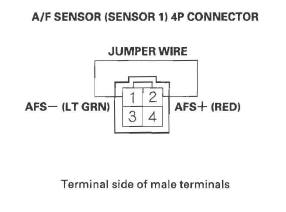
10. Check for continuity between PCM connector , terminals C29 and C30.
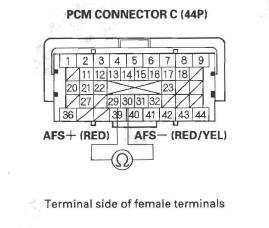
Is there continuity? YES-Go to step 14.
NO-Go to step 11.
11. Remove the jumper wire from the A/F sensor (Sensor 1) 4P connector.
12. Connect A/F sensor (Sensor 1) 4P connector terminal No.2 to body ground with a jumper wire.
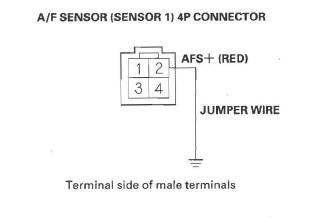
13. Check for continuity between PCM connector terminal C29 and body ground.
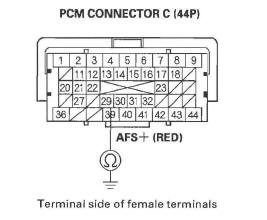
Is there continuity? YES-Repair open in the wire between the PCM (C30) and the A/F sensor (Sensor 1), then go to step 15.
NO-Repair open in the wire between the PCM (C29) and the A/F sensor (Sensor 1), then go to step 15.
14. Replace the A/F sensor (Sensor 1).
15. Reconnect all connectors.
16. Turn the ignition switch ON (II).
17. Reset the PCM with the HDS.
18. Do the PCM idle learn procedure.
19. Check for Temporary DTCs or DTCs with the HDS.
Is DTC P1157 indicated? YES-Check for poor connections or loose terminals at the A/F sensor (Sensor 1) and the PCM, then go to step 1. If the connector and terminal fits are OK, go to step 21.
NO-Go to step 20.
20. Monitor the OBD STATUS for DTC Pl157 in the DTCs MENU with the HDS.
Does the screen indicate PASSED? YES-Troubleshooting is complete. If any other Temporary DTCs or DTCs were indicated in step 19, go to the indicated DTC's troubleshooting.
NO-If the screen indicates FAILED, check for poor connections or loose terminals at the A/F sensor (Sensor 1) and the PCM, then go to step 1. If the screen indicates NOT COMPLETED, go to step 18.
21. Update the PCM if it does not have the latest software, or substitute a known-good PCM.
22. Start the engine.
23. Check for Temporary DTCs or DTCs with the HDS.
Is DTC P1157 indicated? YES-If the PCM was updated, substitute a known-good PCM, then go to step 22. If the PCM was substituted, go to step 1.
NO-Go to step 24.
24. Monitor the OBD STATUS for DTC P1157 in the DTCs MENU with the HDS.
Does the screen indicate PASSED? YES-If the PCM was updated, troubleshooting is complete. If the PCM was substituted, replace the original PCM. If any other Temporary DTCs or DTCs were indicated in step 23, go to the indicated DTC's troubleshooting.
NO-If the screen indicates FAILED, go to step 1. If the PCM was updated, substitute a known-good PCM, then go to step 22. If the PCM was substituted, go to step 1. If the screen indicates NOT COMPLETED, keep idling until a result comes on.
DTC P1172: A/F Sensor (Sensor 1) Circuit Out of Range High
NOTE: Before you troubleshoot, record all freeze data and any on-board snapshot, and review the general troubleshooting information.
1. Turn the ignition switch ON (II).
2. Clear the DTC with the HDS.
3. Start the engine. Hold the engine speed at 3,000 rpm without load (in Park or neutral) until the radiator fan comes on, then let it idle.
4. Monitor the OBD STATUS for DTC P1172 in the DTCs MENU with the HDS.
Does the screen indicate FAILED? YES-Go to step 5.
NO-If the screen indicates PASSED, intermittent failure, the system is OK at this time. Check for poor connections or loose terminals at the A/F sensor (Sensor 1) and the PCM. If the screen indicates EXECUTING, keep driving until a result comes on. If the screen indicates OUT OF CONDITION, go to step 3 and recheck.
5. Turn the ignition switch OFF.
6. Replace the A/F sensor (Sensor 1).
7. Turn the ignition switch ON (II).
8. Reset the PCM with the HDS.
9. Do the PCM idle learn procedure.
10. Start the engine. Hold the engine speed at 3,000 rpm without load (in Park or neutral) until the radiator fan comes on, then let it idle.
11. Check for Temporary DTCs or DTCs with the HDS.
Is DTC P1172 indicated? YES-Check for poor connections or loose terminals at the A/F sensor (Sensor 1) and the PCM, then go to step 1.
NO-Go to step 12.
12. Monitor the OBO STATUS for DTC P1172 in the DTCs MENU with the HDS.
Does the screen indicate PASSED? YES-Troubleshooting is complete. If any other Temporary DTCs or DTCs were indicated in step 11, go to the indicated DTC's troubleshooting.
NO-If the screen indicates FAILED, check for poor connections or loose terminals at the A/F sensor (Sensor 1) and the PCM, then go to step 1. If the screen indicates EXECUTING, keep idling until a result comes on. If the screen indicates OUT OF CONDITION, go to step 10.
DTC P1297: ELD Circuit Low Voltage
NOTE: Before you troubleshoot, record all freeze data and any on-board snapshot, and review the general troubleshooting information.
1. Turn the ignition switch ON (II).
2. Check the ELD in the DATA LIST with the HDS.
Is 72 A or more indicated? YES-Go to step 3.
NO-Intermittent failure, the system is OK at this time. Check for poor connections or loose terminals at the ELD and the PCM.
3. Turn the ignition switch OFF.
4. Disconnect the ELD 3P connector.
5. Turn the ignition switch ON (II).
6. Check the ELD in the DATA LIST with the HDS.
Is 72 A or more indicated? YES-Go to step 7.
NO-Go to step 11.
7. Turn the ignition switch OFF.
8. Jump the SCS line with the HDS.
9. Disconnect PCM connector A (44P).
10. Check for continuity between PCM connector terminal A23 and body ground.
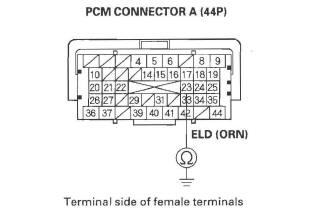
Is there continuity? YES-Repair short in the wire between the PCM (A23) and the ELD, then go to step 13.
NO-Go to step 20.
11. Turn the ignition switch OFF.
12. Replace the under-hood fuse/relay box.
13. Reconnect all connectors.
14. Turn the ignition switch ON (II).
15. Reset the PCM with the HDS.
16. Do the PCM idle learn procedure.
17. Start the engine.
18. Turn on the headlights.
19. Check for Temporary DTCs or DTCs with the HDS.
Is DTC P1297 indicated? YES-Check for poor connections or loose terminals at the ELD and the PCM, then go to step 1.
NO-Troubleshooting is complete. If any other Temporary DTCs or DTCs are indicated, go to the indicated DTC's troubleshooting.
20. Reconnect all connectors.
21. Update the PCM if it does not have the latest software, or substitute a known-good PCM.
22. Start the engine.
23. Turn on the headlights.
24. Check for Temporary DTCs or DTCs with the HDS.
Is DTC P1297 indicated?
YES-Check for poor connections or loose terminals at the ELD and the PCM. If the PCM was updated, substitute a known-good PCM, then go to step 22. If the PCM was substituted, go to step 1.
NO-If the PCM was updated, troubleshooting is complete. If the PCM was substituted, replace the original PCM. If any other Temporary DTCs or DTCs are indicated, go to the indicated DTC's troubleshooting.
DTC P1298: ELD Circuit High Voltage
NOTE: Before you troubleshoot, record all freeze data and any on-board snapshot, and review the general troubleshooting information.
1. Turn the ignition switch ON (II).
2. Check the ELD in the DATA LIST with the HDS.
Is 0.2 A or less indicated? YES-Go to step 3.
NO-Intermittent failure, the system is OK at this time. Check for poor connections or loose terminals at the ELD and the PCM.
3. Turn the ignition switch OFF.
4. Disconnect the ELD 3P connector.
5. Turn the ignition switch ON (II).
6. Measure voltage between ELD 3P connector terminal No.1 and body ground.
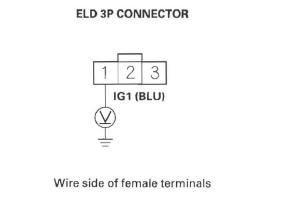
Is there battery voltage? YES-Go to step 7.
NO-Check the No. 3 ALTERNATOR (10 A) fuse in the under-dash fuse/relay box. If the fuse is OK, repair open in the wire between the No.3 ALTERNATOR (10 A) fuse and the ELD, then go to step 12.
7. Jump the SCS line with the HDS.
8. Disconnect PCM connector A (44P).
9. Check for continuity between ELD 3P connector terminal No.3 and PCM connector terminal A23.
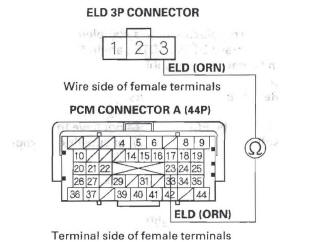
Is there continuity? YES-Go to step 10.
NO-Repair open in the wire between the PCM (A23) and the ELD, then go to step 12.
10. Check for continuity between ELD 3P connector terminal No.2 and body ground.
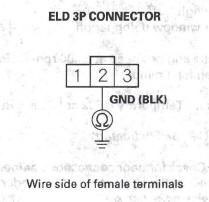
Is there continuity? YES-Go to step 11.
NO-Repair open in the wire between the ELD and G302, then go to step 12.
11. Replace the under-hood fuse/relay box.
12. Reconnect all connectors.
13. Turn the ignition switch ON (II).
14. Reset the PCM with the HDS.
15. Do the PCM idle learn procedure.
16. Check for Temporary DTCs or DTCs with the HDS.
Is DTC P1298 indicated? YES-Go to step 17.
NO-Troubleshooting is complete. If any other Temporary DTCs or DTCs are indicated, go to the indicated DTC's troubleshooting.
17. Update the PCM if it does not have the latest software, or substitute a known-good PCM.
18. Check for Temporary DTCs or DTCs with the HDS.
Is DTC P1298 indicated? YES-Check for poor connections or loose terminals at the ELD and the PCM. If the PCM was updated, substitute a known-good PCM, then recheck. If the PCM was substituted, go to step 1.
NO-If the PCM was updated, troubleshooting is complete. If the PCM was substituted, replace the original PCM. If any other Temporary DTCs or DTCs are indicated, go to the indicated DTC's troubleshooting.

